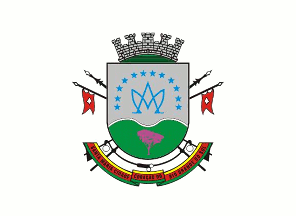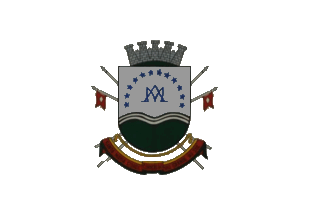 image by Ivan Sache,
4 August 2020
image by Ivan Sache,
4 August 2020
Last modified: 2020-08-08 by ian macdonald
Keywords: rio grande do sul | santa maria |
Links: FOTW homepage |
search |
disclaimer and copyright |
write us |
mirrors
 image by Ivan Sache,
4 August 2020
image by Ivan Sache,
4 August 2020
The municipality of Santa Maria (261,031 inhabitants in 2010, 95% in urban
area; 17,881 ha) is located 300 km west of Porto Alegre and 250 km north-east of
Rivera, the closest border town in Uruguay.
The municipality is composed of
the districts of Santa Maria (seat, divided in 41 boroughs), São Valentim,
Pains, Arroio Grande, Arroio do Só, Passo do Verde, Boca do Monte, Palma, Santa
Flora and Santo Antão.
Santa Maria emerged in a territory settled by
Jesuit missions until the Treaty of Madrid, signed in 1750 by Portugal and
Spain; accordingly, the missions were suppressed and their territory was shared
between the two colonial empires. The Treaty of San Ildefonso, aka Preliminary
Treaty of Reciprocal Restitutions, signed in 1777, was expected to solve the
issues left by past border wars between the two powers.
The first written
record of the region is found in the "Diário da Demarcação de Limites da América
Meridional" (Report of the Demarcation of Southern America Limits) published in
1787 by the astronomer José Saldanha, member of the binational commission. At
the same time, the region assigned to Portugal was settled by colonists coming
from Paraná and São Paulo. Santa Maria emerged in 1784 around a military camp
established on the territory of Cachoeira do Sul.
On 26 April 1819,
Cachoeira was granted the status of "vila", Santa Maria being elevated to its
4th district. Visiting the town in 1821, the French naturalist Auguste de
Sainte-Hilaire noticed some 30 houses, a beautiful natural environment and
intense trade. The first census, organized in 1826, yielded 304 dwellings and
2,128 inhabitants.
To watch the border, the 28th Foreign Battalions and
the 1st Battalion were established in Santa Maria in 1828 and 1831,
respectively. Composed of German professional soldiers, these units
significantly contributed to the settlement of the region; at the end of their
service, several soldiers established German colonies, such as São Leopoldo,
initiating a cycle of German settlement in the region. The strategic value of
Santa Maria remained important even after the transfer of the border to river
Uruguai.
The parish of Santa Maria da Boca do Monte was established by
Law No. 6. promulgated on 17 November 1837. The municipality of Santa Maria da
Boca do Monte was established by Law No. 400, promulgated on 16 December 1857,
and inaugurated on 17 May 1858. The new town was designed in 1861 by land
surveyor Otto Brinckmann.
Santa Maria was granted the status of "cidade" by
Provincial Law No. 1,013, promulgated on 6 April 1876. In 1887, the municipality
counted 11,000 inhabitants, 3,000 in the town proper. The first municipal
Constitution was adopted on 8 October 1892.
http://santamariaemdados.com.br/
Santa Maria Development Agency
Ivan Sache, 4 August 2020
A white flag with the
municipal arms in the centre.
Dirk Schönberger,
22 March 2012
The flag of Santa Maria is prescribed by a Municipal Law, unfortunately not
specified:
The municipality flag shall have a rectangular field, charged in
the center with the heraldic symbol (or coat of arms) of Santa Maria.
White
symbolizes the spirit of peace of the Santa Maria community.
http://santamariaemdados.com.br/1-aspectos-gerais/1-1-simbolos-do-municipio/
Santa Maria Development Agency
Videos
https://www.camara-sm.rs.gov.br/tvcamara/assistir/TV_Camara/168/6795/
https://www.camara-sm.rs.gov.br/tvcamara/assistir/TV_Camara/180/6755/
The coat of arms of Santa Maria is prescribed by Municipal Law No. 785
promulgated on 20 December 1958.
A Portuguese shield, argent the Maria
Santíssima monogram in blue, surrounded by 12 stars of the same in base two
mounts proper. Supporters: two lances with red pennants charged with a white
lozenge crossed in saltire. The shield superimposed to two indigenous lances
arranged in the same pattern linked by a Gaúcho boleadeira.
Motto: on a
scroll to the colors of the flag of Piratini, the black writing "SANTA MARIA,
CIDADE CORAÇÃO DO RIO GRANDE DO SUL".
Crest: A five-towered mural crown
argent.
https://leismunicipais.com.br/a/rs/s/santa-maria/lei-ordinaria/1958/79/785/lei-ordinaria-n-785-1958-adota-o-simbolo-heraldico-de-santa-maria-e-da-outras-providencias
Leis Municipais database
According to Aristilda Rechia (Santa Maria:
Panorama Histórico Cultural. Associação Santamariense de Letras, 2006), the
indigenous lances and the boleadeiras recall the first inhabitants of the
region, consecrated in the Imembuí legend. The military lances with pennants
recall the occupation and defense of the region by governmental regular forces
and the Gaúcho bellicose tradition.
The five-towered mural crown indicates
the status of "cidade".
The Marian monogram is a tribute to the town's patron
saint and namesake, as well as the argent and blue colors.
The base
represents the small hills characteristic of the town's topography.
http://santamariaemdados.com.br/1-aspectos-gerais/1-1-simbolos-do-municipio/
Santa Maria Development Agency
Boleadeiras, throwing weapons made of
weights on the ends of interconnected cords, were widely used by natives to
capture game. Gaúcho borrowed boleadeiras from the Pampa tribes and made of them
their emblematic tool, used to capture cattle.
The Imembuí legend is
Santa Maria's founding myth.
Imembuí was a young Indian woman, born on the
bank of river Taimbé from a tribe living peacefully in the Ybitory-Retan
(Tupi-Guarani, Land of Joy) region. Threatened by Portuguese pioneers, the Tape
and Minuano tribes set up an ambush and caught the invaders. Imembuí fell in
love with prisoner Rodrigo and saved him from death; he married her under the
name of Morotin and they had a son names José.
In an article published on
June 2001 in the review "Letra de Hoje", Pr. Orlando Fonseca explains that the
origin of the legend has been lost in the mists of times. Its first written
record is credited to the writer Cezimbra Jaques in the novel "Assuntos de Rio
Grande", published in 1912. The historian João Bélem reported the mythic origin
in Santa Maria in the book "História do Município de Santa Maria – 1797-1933",
published in 1933.
"The Imembuí legend" is a mural painting (14.5 m x 2.8 m)
designed in 1976 by Eduardo Trevisan in the main campus of Universidade Federal
de Santa Maria (UFSM). The project was pushed by the Rector of the newly
established university, José Mariano de Rocha Filho, on the model of the famous
mural paintings designed by Diego Rivera in Universidade de México (UNAM). The
work was completely restored in 2018 by Flamarion Trevisan, the designer's son.
https://www.ufsm.br/2018/11/21/restauracao-mural-trevisan/
UFSM, 21
November 2018
 image by Ivan Sache,
4 August 2020
image by Ivan Sache,
4 August 2020
The official description of the arms of Santa Maria lacks
the
ipê-roxo tree featured in the shield's base. This was indeed a later addition
prescribed in Municipal Law No. 3,079 promulgated on 13 December 1988.
Article 1.
The tree species colloquially known as ipê-roxo shall be
considered as the symbol tree of the municipality.
Article 2.
The
symbol shall be included into the coat of arms of the municipality.
https://leismunicipais.com.br/a/rs/s/santa-maria/lei-ordinaria/1988/308/3079/lei-ordinaria-n-3079-1988-considera-o-ipe-a-arvore-simbolo-do-municipio
Leis Municipais database
Ipê-roxo, Handroanthus heptaphyllus
(Vell.) Mattos (pink trumpet tree, pink tab) is a medium-sized tree that
profusely flowers from June to August. Widely used by landscape gardeners to
embellish urban environments, the tree is also of economic significance due to
its wood ("pau-brasil") and medicinal properties of its leaf extracts.
Pink
tab was proclaimed Paraguay's national tree on 10 May 2012.
http://santamariaemdados.com.br/1-aspectos-gerais/1-1-simbolos-do-municipio/
Santa Maria Development Agency
The Santa Maria Municipal Historic
Archives feature a photo the the municipal flag "produced between 1980 and
1999", with, as expected, the coat of arms lacking the ipê-roxo tree.
Photo
http://web2.santamaria.rs.gov.br/arquivohistorico/sistema_descricao_documental/index.php/pjykz;isad
The use of the colors of the flag of Piratini - also the colors of the
flag of Rio Grande do Sul on the scroll is a straightforward reference to the
Riograndese Republic (1836-1845), proclaimed in Piratini by the Gaúcho oligarchy
as a secession from the Brazilian Empire. Gaúchos consider the Republic as the
historic symbol of their idiosyncrasy and Rio Grande do Sul State as a kind of
continuation of it.
Ivan Sache, 4 August 2020